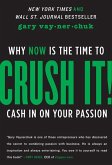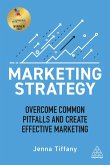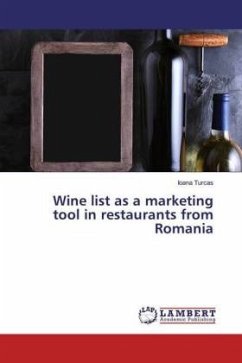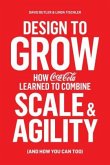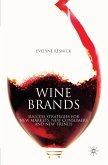- Gebundenes Buch
- Merkliste
- Auf die Merkliste
- Bewerten Bewerten
- Teilen
- Produkt teilen
- Produkterinnerung
- Produkterinnerung
A textbook and practitioner’s guide, written by a leading Professor of Wine Business and a seasoned luxury wine marketing practitioner. It describes the history and best practices of marketing luxury wine, and includes case studies of wineries from around the world, as well as new, primary research into the market size of luxury wine. Wine has been considered a luxury product since the time of the ancient Egyptians, and today is coveted by collectors and wine enthusiasts from around the world. Yet little has been written about the world of luxury wine marketing, explaining how a wine brand can…mehr
Andere Kunden interessierten sich auch für
![Crush It! Crush It!]() Gary VaynerchukCrush It!11,99 €
Gary VaynerchukCrush It!11,99 €![Marketing Strategy Marketing Strategy]() Jenna TiffanyMarketing Strategy110,99 €
Jenna TiffanyMarketing Strategy110,99 €![Wine list as a marketing tool in restaurants from Romania Wine list as a marketing tool in restaurants from Romania]() Ioana TurcasWine list as a marketing tool in restaurants from Romania36,99 €
Ioana TurcasWine list as a marketing tool in restaurants from Romania36,99 €![Design to Grow Design to Grow]() David ButlerDesign to Grow20,99 €
David ButlerDesign to Grow20,99 €![Country of origin effect on the behaviour of the Irish wine consumer Country of origin effect on the behaviour of the Irish wine consumer]() Helene ViotCountry of origin effect on the behaviour of the Irish wine consumer36,99 €
Helene ViotCountry of origin effect on the behaviour of the Irish wine consumer36,99 €![Wine Brands Wine Brands]() E. ResnickWine Brands53,99 €
E. ResnickWine Brands53,99 €![The Country of Origin Effect on Greek Consumers¿ Evaluation of Wine The Country of Origin Effect on Greek Consumers¿ Evaluation of Wine]() Cristin CuflicThe Country of Origin Effect on Greek Consumers¿ Evaluation of Wine24,99 €
Cristin CuflicThe Country of Origin Effect on Greek Consumers¿ Evaluation of Wine24,99 €-
-
-
A textbook and practitioner’s guide, written by a leading Professor of Wine Business and a seasoned luxury wine marketing practitioner. It describes the history and best practices of marketing luxury wine, and includes case studies of wineries from around the world, as well as new, primary research into the market size of luxury wine. Wine has been considered a luxury product since the time of the ancient Egyptians, and today is coveted by collectors and wine enthusiasts from around the world. Yet little has been written about the world of luxury wine marketing, explaining how a wine brand can enter that special realm. This book helps to demystify the process by describing how to craft, implement, and maintain a luxury wine brand. Beginning with a definition and history of luxury wine, the authors then explain the unique business model and consumer segments for luxury wine, before outlining industry best practice in the building of luxury wine brands. Each chapter is supplemented with a vignette of a successful luxury brand producer, and provides beneficial advice on the long-term vision and passion that is necessary to create a successful luxury wine marketing strategy. This book also contains original research conducted by the authors on the size of the luxury wine market and analysis of its segmentation by region, allowing for new and unique insight into the world’s top wine regions. Written as both a practitioner’s guide and as a wine business textbook, Luxury Wine Marketing is a cornerstone reference resource for the business of wine.
Produktdetails
- Produktdetails
- Verlag: Academie Du Vin Library Ltd
- Seitenzahl: 288
- Erscheinungstermin: 7. Februar 2024
- Englisch
- Abmessung: 234mm x 156mm x 29mm
- Gewicht: 606g
- ISBN-13: 9781913141578
- ISBN-10: 1913141578
- Artikelnr.: 70005728
- Herstellerkennzeichnung
- Libri GmbH
- Europaallee 1
- 36244 Bad Hersfeld
- gpsr@libri.de
- Verlag: Academie Du Vin Library Ltd
- Seitenzahl: 288
- Erscheinungstermin: 7. Februar 2024
- Englisch
- Abmessung: 234mm x 156mm x 29mm
- Gewicht: 606g
- ISBN-13: 9781913141578
- ISBN-10: 1913141578
- Artikelnr.: 70005728
- Herstellerkennzeichnung
- Libri GmbH
- Europaallee 1
- 36244 Bad Hersfeld
- gpsr@libri.de
Dr. Liz Thach MW is the Distinguished Professor of Wine and Management at Sonoma State University where she teaches on both the undergraduate and Wine MBA programs. An award winning author, she has published over 150 articles and 8 wine books. Thach holds a PhD from Texas A&M and became a Master of Wine in 2011. She also works as a wine judge in various competitions, and has served on many non-profit wine boards. Peter Yeung is a leading wine-business consultant. He was previously VP of Strategy and Business Development at Kosta Browne Winery and Realm Cellars, both in California, where he developed and executed strategic marketing plans, and a senior consultant at McKinsey & Company. He holds an MSc from the London School of Economics and a BA in Economics from the UC, Berkeley.
Foreword by Clive Coates, MW ix Acknowledgements xi Introduction 1 1.
Luxury wine defined 3 The luxury wine experience 4 Luxury wine: luxuriously
defined 5 What luxury wine is not 7 The vision behind luxury wine 8
Vignette: the epitome of luxury wine – Dom Perignon 9 2. The history of
luxury wine and key players to day 12 The origin of the term “luxury” 13 A
brief history of luxury wine 13 Luxury and the impact of economic growth 16
Key players in luxury wine 17 Vignette: Screaming Eagle transitions from
cult to luxury wine 23 3. Luxury wine market size and pro fita bility 26
The luxury wine business model 27 Luxury wine: global market size 27 Luxury
wine profitability in context 29 Luxury wine market by region 30
Profitability of luxury wine 37 Benefits and challenges of the luxury wine
business 43 Vignette: delivering a vision, the global success of Opus One
46 4. Luxury wine consumers 49 Who is the luxury consumer? Motivations and
perceptions 50 Luxury consumer segmentation 52 Global differences in luxury
consumers 54 Analyzing the luxury wine buyer 55 Creation of a luxury wine
consumer segmentation 57 Vignette: Château Lafite Rothschild taps into
consumer desires 61 5. How luxury wine strategy works 65 Standing out from
the crowd 66 A pyramid approach to strategy 67 Vision provides the “North
Star” 68 Strategy – the where and how to compete 69 The 5P+S of luxury wine
marketing 69 Tactics and initiatives – implementation 70 Luxury wine
business models 72 Measurement is the key to success 73 Managing luxury
wine and keeping the brand fresh 76 Vignette: Guigal – building a luxury
wine empire with a long-term view 76 6. Cra fting the luxury wine pro duct
79 Eight critical elements of the luxury wine product 80 Sacred location
for high quality 81 Master vigneron and team 82 Balance of nature and
technology 83 Quality craftsmanship to highlight the vintage 85 Aging with
grace 86 Art of the blend 87 Authentic luxury service 88 Entry level for
dreamers 89 Vignette: crafting the “product” of Domaine de la Romanée-Conti
90 7. Setting luxury wine pricing 94 The importance of pricing luxury wine
95 The luxury wine price continuum 96 Determining pricing structure 100
Price evolution: the implications of changing pricing on luxury wines 108
Bordeaux en primeur: a market-based pricing system 113 Second labels: a
method for luxury wine price reductions 114 Vignette: Harlan Estate –
creating global scarcity to preserve pricing power 115 8. Telling the
luxury wine story 118 Defining the “luxury wine brand story” 119 Research
on the power of brand storytelling 120 Key components of the brand story –
setting, characters, plot, moral 120 A symbol arising from the story 126
Crafting a distinctive luxury wine story or adding a new chapter 126 Focus
on craftsmanship and authenticity 128 Importance of the human element –
building relationships through storytelling 129 Communicating consistency,
integrity, and humility 130 Delivering the story 130 Vignette: master
storytelling at Tenuta Tignanello, Italy 131 9. Luxury wine packaging 134
The importance of luxury packaging 135 Luxury bottles – from historic to
futuristic “smart bottles” 136 The luxury closure – to cork or not? 138
Consumer research on label design 139 Luxury boxes and containers –
environmentally friendly 140 Tracking and shipping considerations 141 Dos
and don’ts of luxury wine packaging 141 Vignette: crystal clear Cristal 144
10. Managing scarcity and placement 146 The importance of managing scarcity
and placement 147 Overview of DTC and trade placement 147 Direct to
consumer sales channels 148 Trade sales channels 161 Vignette: Vega Sicilia
– the original allocated offering 166 11. Promoting luxury wine 168
Promoting luxury softly 169 How luxury promotion is different from
commercial wine promotion 170 Luxury wine promotion toolkit 172 Launching a
new luxury wine product 203 Vignette: the Berlin tasting – establishing
Chilean wine in the luxury marketplace 205 12. Luxury wine management 208
It is always about the people 209 Sales and marketing convergence 212
Building long-term relationships with customers 213 Continuous improvement
214 Motivating luxury employees 216 Succession planning 217 Vignette:
Artemis Domaines – driving beyond a first growth 218 13. Managing the secon
dary market and counter feits 221 Secondary market overview 223 The auction
market 224 Major auction houses 226 Auction buyers 228 Retailers in the
secondary market 229 Managing the secondary market 229 Counterfeits 233
Preventing counterfeits 234 Vignette: Pétrus – the world’s most
counterfeited wine 235 14. Keeping the luxury brand fresh 238 The
importance of long-term vision 239 Traditional ways of keeping the brand
fresh 240 Staying relevant in a changing world 241 Penfolds: innovation and
collaboration to keep the brand fresh 242 Managing through an economic
downturn 247 Vignette: the continual evolution of Gaja 248 References 251
About the authors 269 Index 271
Luxury wine defined 3 The luxury wine experience 4 Luxury wine: luxuriously
defined 5 What luxury wine is not 7 The vision behind luxury wine 8
Vignette: the epitome of luxury wine – Dom Perignon 9 2. The history of
luxury wine and key players to day 12 The origin of the term “luxury” 13 A
brief history of luxury wine 13 Luxury and the impact of economic growth 16
Key players in luxury wine 17 Vignette: Screaming Eagle transitions from
cult to luxury wine 23 3. Luxury wine market size and pro fita bility 26
The luxury wine business model 27 Luxury wine: global market size 27 Luxury
wine profitability in context 29 Luxury wine market by region 30
Profitability of luxury wine 37 Benefits and challenges of the luxury wine
business 43 Vignette: delivering a vision, the global success of Opus One
46 4. Luxury wine consumers 49 Who is the luxury consumer? Motivations and
perceptions 50 Luxury consumer segmentation 52 Global differences in luxury
consumers 54 Analyzing the luxury wine buyer 55 Creation of a luxury wine
consumer segmentation 57 Vignette: Château Lafite Rothschild taps into
consumer desires 61 5. How luxury wine strategy works 65 Standing out from
the crowd 66 A pyramid approach to strategy 67 Vision provides the “North
Star” 68 Strategy – the where and how to compete 69 The 5P+S of luxury wine
marketing 69 Tactics and initiatives – implementation 70 Luxury wine
business models 72 Measurement is the key to success 73 Managing luxury
wine and keeping the brand fresh 76 Vignette: Guigal – building a luxury
wine empire with a long-term view 76 6. Cra fting the luxury wine pro duct
79 Eight critical elements of the luxury wine product 80 Sacred location
for high quality 81 Master vigneron and team 82 Balance of nature and
technology 83 Quality craftsmanship to highlight the vintage 85 Aging with
grace 86 Art of the blend 87 Authentic luxury service 88 Entry level for
dreamers 89 Vignette: crafting the “product” of Domaine de la Romanée-Conti
90 7. Setting luxury wine pricing 94 The importance of pricing luxury wine
95 The luxury wine price continuum 96 Determining pricing structure 100
Price evolution: the implications of changing pricing on luxury wines 108
Bordeaux en primeur: a market-based pricing system 113 Second labels: a
method for luxury wine price reductions 114 Vignette: Harlan Estate –
creating global scarcity to preserve pricing power 115 8. Telling the
luxury wine story 118 Defining the “luxury wine brand story” 119 Research
on the power of brand storytelling 120 Key components of the brand story –
setting, characters, plot, moral 120 A symbol arising from the story 126
Crafting a distinctive luxury wine story or adding a new chapter 126 Focus
on craftsmanship and authenticity 128 Importance of the human element –
building relationships through storytelling 129 Communicating consistency,
integrity, and humility 130 Delivering the story 130 Vignette: master
storytelling at Tenuta Tignanello, Italy 131 9. Luxury wine packaging 134
The importance of luxury packaging 135 Luxury bottles – from historic to
futuristic “smart bottles” 136 The luxury closure – to cork or not? 138
Consumer research on label design 139 Luxury boxes and containers –
environmentally friendly 140 Tracking and shipping considerations 141 Dos
and don’ts of luxury wine packaging 141 Vignette: crystal clear Cristal 144
10. Managing scarcity and placement 146 The importance of managing scarcity
and placement 147 Overview of DTC and trade placement 147 Direct to
consumer sales channels 148 Trade sales channels 161 Vignette: Vega Sicilia
– the original allocated offering 166 11. Promoting luxury wine 168
Promoting luxury softly 169 How luxury promotion is different from
commercial wine promotion 170 Luxury wine promotion toolkit 172 Launching a
new luxury wine product 203 Vignette: the Berlin tasting – establishing
Chilean wine in the luxury marketplace 205 12. Luxury wine management 208
It is always about the people 209 Sales and marketing convergence 212
Building long-term relationships with customers 213 Continuous improvement
214 Motivating luxury employees 216 Succession planning 217 Vignette:
Artemis Domaines – driving beyond a first growth 218 13. Managing the secon
dary market and counter feits 221 Secondary market overview 223 The auction
market 224 Major auction houses 226 Auction buyers 228 Retailers in the
secondary market 229 Managing the secondary market 229 Counterfeits 233
Preventing counterfeits 234 Vignette: Pétrus – the world’s most
counterfeited wine 235 14. Keeping the luxury brand fresh 238 The
importance of long-term vision 239 Traditional ways of keeping the brand
fresh 240 Staying relevant in a changing world 241 Penfolds: innovation and
collaboration to keep the brand fresh 242 Managing through an economic
downturn 247 Vignette: the continual evolution of Gaja 248 References 251
About the authors 269 Index 271
Foreword by Clive Coates, MW ix Acknowledgements xi Introduction 1 1.
Luxury wine defined 3 The luxury wine experience 4 Luxury wine: luxuriously
defined 5 What luxury wine is not 7 The vision behind luxury wine 8
Vignette: the epitome of luxury wine – Dom Perignon 9 2. The history of
luxury wine and key players to day 12 The origin of the term “luxury” 13 A
brief history of luxury wine 13 Luxury and the impact of economic growth 16
Key players in luxury wine 17 Vignette: Screaming Eagle transitions from
cult to luxury wine 23 3. Luxury wine market size and pro fita bility 26
The luxury wine business model 27 Luxury wine: global market size 27 Luxury
wine profitability in context 29 Luxury wine market by region 30
Profitability of luxury wine 37 Benefits and challenges of the luxury wine
business 43 Vignette: delivering a vision, the global success of Opus One
46 4. Luxury wine consumers 49 Who is the luxury consumer? Motivations and
perceptions 50 Luxury consumer segmentation 52 Global differences in luxury
consumers 54 Analyzing the luxury wine buyer 55 Creation of a luxury wine
consumer segmentation 57 Vignette: Château Lafite Rothschild taps into
consumer desires 61 5. How luxury wine strategy works 65 Standing out from
the crowd 66 A pyramid approach to strategy 67 Vision provides the “North
Star” 68 Strategy – the where and how to compete 69 The 5P+S of luxury wine
marketing 69 Tactics and initiatives – implementation 70 Luxury wine
business models 72 Measurement is the key to success 73 Managing luxury
wine and keeping the brand fresh 76 Vignette: Guigal – building a luxury
wine empire with a long-term view 76 6. Cra fting the luxury wine pro duct
79 Eight critical elements of the luxury wine product 80 Sacred location
for high quality 81 Master vigneron and team 82 Balance of nature and
technology 83 Quality craftsmanship to highlight the vintage 85 Aging with
grace 86 Art of the blend 87 Authentic luxury service 88 Entry level for
dreamers 89 Vignette: crafting the “product” of Domaine de la Romanée-Conti
90 7. Setting luxury wine pricing 94 The importance of pricing luxury wine
95 The luxury wine price continuum 96 Determining pricing structure 100
Price evolution: the implications of changing pricing on luxury wines 108
Bordeaux en primeur: a market-based pricing system 113 Second labels: a
method for luxury wine price reductions 114 Vignette: Harlan Estate –
creating global scarcity to preserve pricing power 115 8. Telling the
luxury wine story 118 Defining the “luxury wine brand story” 119 Research
on the power of brand storytelling 120 Key components of the brand story –
setting, characters, plot, moral 120 A symbol arising from the story 126
Crafting a distinctive luxury wine story or adding a new chapter 126 Focus
on craftsmanship and authenticity 128 Importance of the human element –
building relationships through storytelling 129 Communicating consistency,
integrity, and humility 130 Delivering the story 130 Vignette: master
storytelling at Tenuta Tignanello, Italy 131 9. Luxury wine packaging 134
The importance of luxury packaging 135 Luxury bottles – from historic to
futuristic “smart bottles” 136 The luxury closure – to cork or not? 138
Consumer research on label design 139 Luxury boxes and containers –
environmentally friendly 140 Tracking and shipping considerations 141 Dos
and don’ts of luxury wine packaging 141 Vignette: crystal clear Cristal 144
10. Managing scarcity and placement 146 The importance of managing scarcity
and placement 147 Overview of DTC and trade placement 147 Direct to
consumer sales channels 148 Trade sales channels 161 Vignette: Vega Sicilia
– the original allocated offering 166 11. Promoting luxury wine 168
Promoting luxury softly 169 How luxury promotion is different from
commercial wine promotion 170 Luxury wine promotion toolkit 172 Launching a
new luxury wine product 203 Vignette: the Berlin tasting – establishing
Chilean wine in the luxury marketplace 205 12. Luxury wine management 208
It is always about the people 209 Sales and marketing convergence 212
Building long-term relationships with customers 213 Continuous improvement
214 Motivating luxury employees 216 Succession planning 217 Vignette:
Artemis Domaines – driving beyond a first growth 218 13. Managing the secon
dary market and counter feits 221 Secondary market overview 223 The auction
market 224 Major auction houses 226 Auction buyers 228 Retailers in the
secondary market 229 Managing the secondary market 229 Counterfeits 233
Preventing counterfeits 234 Vignette: Pétrus – the world’s most
counterfeited wine 235 14. Keeping the luxury brand fresh 238 The
importance of long-term vision 239 Traditional ways of keeping the brand
fresh 240 Staying relevant in a changing world 241 Penfolds: innovation and
collaboration to keep the brand fresh 242 Managing through an economic
downturn 247 Vignette: the continual evolution of Gaja 248 References 251
About the authors 269 Index 271
Luxury wine defined 3 The luxury wine experience 4 Luxury wine: luxuriously
defined 5 What luxury wine is not 7 The vision behind luxury wine 8
Vignette: the epitome of luxury wine – Dom Perignon 9 2. The history of
luxury wine and key players to day 12 The origin of the term “luxury” 13 A
brief history of luxury wine 13 Luxury and the impact of economic growth 16
Key players in luxury wine 17 Vignette: Screaming Eagle transitions from
cult to luxury wine 23 3. Luxury wine market size and pro fita bility 26
The luxury wine business model 27 Luxury wine: global market size 27 Luxury
wine profitability in context 29 Luxury wine market by region 30
Profitability of luxury wine 37 Benefits and challenges of the luxury wine
business 43 Vignette: delivering a vision, the global success of Opus One
46 4. Luxury wine consumers 49 Who is the luxury consumer? Motivations and
perceptions 50 Luxury consumer segmentation 52 Global differences in luxury
consumers 54 Analyzing the luxury wine buyer 55 Creation of a luxury wine
consumer segmentation 57 Vignette: Château Lafite Rothschild taps into
consumer desires 61 5. How luxury wine strategy works 65 Standing out from
the crowd 66 A pyramid approach to strategy 67 Vision provides the “North
Star” 68 Strategy – the where and how to compete 69 The 5P+S of luxury wine
marketing 69 Tactics and initiatives – implementation 70 Luxury wine
business models 72 Measurement is the key to success 73 Managing luxury
wine and keeping the brand fresh 76 Vignette: Guigal – building a luxury
wine empire with a long-term view 76 6. Cra fting the luxury wine pro duct
79 Eight critical elements of the luxury wine product 80 Sacred location
for high quality 81 Master vigneron and team 82 Balance of nature and
technology 83 Quality craftsmanship to highlight the vintage 85 Aging with
grace 86 Art of the blend 87 Authentic luxury service 88 Entry level for
dreamers 89 Vignette: crafting the “product” of Domaine de la Romanée-Conti
90 7. Setting luxury wine pricing 94 The importance of pricing luxury wine
95 The luxury wine price continuum 96 Determining pricing structure 100
Price evolution: the implications of changing pricing on luxury wines 108
Bordeaux en primeur: a market-based pricing system 113 Second labels: a
method for luxury wine price reductions 114 Vignette: Harlan Estate –
creating global scarcity to preserve pricing power 115 8. Telling the
luxury wine story 118 Defining the “luxury wine brand story” 119 Research
on the power of brand storytelling 120 Key components of the brand story –
setting, characters, plot, moral 120 A symbol arising from the story 126
Crafting a distinctive luxury wine story or adding a new chapter 126 Focus
on craftsmanship and authenticity 128 Importance of the human element –
building relationships through storytelling 129 Communicating consistency,
integrity, and humility 130 Delivering the story 130 Vignette: master
storytelling at Tenuta Tignanello, Italy 131 9. Luxury wine packaging 134
The importance of luxury packaging 135 Luxury bottles – from historic to
futuristic “smart bottles” 136 The luxury closure – to cork or not? 138
Consumer research on label design 139 Luxury boxes and containers –
environmentally friendly 140 Tracking and shipping considerations 141 Dos
and don’ts of luxury wine packaging 141 Vignette: crystal clear Cristal 144
10. Managing scarcity and placement 146 The importance of managing scarcity
and placement 147 Overview of DTC and trade placement 147 Direct to
consumer sales channels 148 Trade sales channels 161 Vignette: Vega Sicilia
– the original allocated offering 166 11. Promoting luxury wine 168
Promoting luxury softly 169 How luxury promotion is different from
commercial wine promotion 170 Luxury wine promotion toolkit 172 Launching a
new luxury wine product 203 Vignette: the Berlin tasting – establishing
Chilean wine in the luxury marketplace 205 12. Luxury wine management 208
It is always about the people 209 Sales and marketing convergence 212
Building long-term relationships with customers 213 Continuous improvement
214 Motivating luxury employees 216 Succession planning 217 Vignette:
Artemis Domaines – driving beyond a first growth 218 13. Managing the secon
dary market and counter feits 221 Secondary market overview 223 The auction
market 224 Major auction houses 226 Auction buyers 228 Retailers in the
secondary market 229 Managing the secondary market 229 Counterfeits 233
Preventing counterfeits 234 Vignette: Pétrus – the world’s most
counterfeited wine 235 14. Keeping the luxury brand fresh 238 The
importance of long-term vision 239 Traditional ways of keeping the brand
fresh 240 Staying relevant in a changing world 241 Penfolds: innovation and
collaboration to keep the brand fresh 242 Managing through an economic
downturn 247 Vignette: the continual evolution of Gaja 248 References 251
About the authors 269 Index 271


